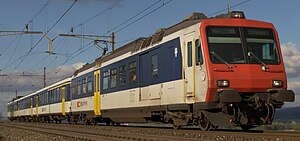SBB-CFF-FFS RBDe 560
|
RBDe 560 between Mühlau and Sins |
|
| Production and service data | |
|---|---|
| Build date (1st series) | 1984, 1987–1990 |
| Road numbers | 2100–2185 |
| Road numbers (UIC) | RBDe 560 000 – RBDe 560 083 Chemin de fer Pont-Brassus PBr RBDe 568 384 - RBDe 568 385 |
| Production | 84 + 2 |
| Build date (2nd series) | 1994–1996 |
| Road numbers (UIC) | RBDe 560 100 – RBDe 560 141 Some changes; see article text |
| Production | 42 |
| Production (both series) | 126 + 2 |
| Services | Regional and S-Bahn traffic |
| Derivative versions | |
| Build date (RBDe 562) | 1997 |
| Road numbers (UIC) | RBDe 562 000 – RBDe 562 005 |
| Services | Basel S-Bahn (SNCF) |
| Build date (RBDe 561) | 2003 |
| Road numbers (UIC) | RBDe 561 000 – RBDe 561 005 |
| Services | Basel S-Bahn (Wiesental) |
| Technical data | |
| Vehicle type | Electric multiple unit |
| Builder (Prototypes) |
FFA Altenrhein BBC Baden |
| Builder (Main series) |
Schindler Waggon Altenrhein BBC Baden / ABB Zürich SIG Neuhausen |
| Builder (Derivatives) | Schindler Waggon Pratteln ABB Zürich / Adtranz Zürich SIG Neuhausen |
| Wheel arrangement | Bo-Bo |
| Top speed | 140 km/h (87 mph) |
| Power | 1,650 kW (2,210 hp) at 75 km/h (47 mph) |
| Continuous traction | 78 kN (18,000 lbf) |
| Maximum traction | 182 kN (41,000 lbf) |
| Size and weight | |
| Length over buffers | 25,000 mm (82 ft 0.3 in) |
| Width | ? mm |
| Height | ? mm |
| Weight | RBDe 560/561: 70 t (68.9 long tons; 77.2 short tons) RBDe 562: 72 t (70.9 long tons; 79.4 short tons) |
| Equipment | |
| Train configuration | RBDe |
| Seats | 56 |
| First class | 0 |
| Second class | 56 |
| Other | |
| Special characteristics | First equipment painted in today's regional traffic color scheme (NPZ/Kolibri) |
| Predecessors | RBe 540 |
| Successors |
Stadler GTW Stadler FLIRT |
The RBDe 560 (in the old naming style, the RBDe 4/4) and its derivatives provide motive power for S-Bahn, suburban, and regional traffic on the Swiss Federal Railways (SBB) network. The derivative versions belong to the SBB as well as various private railroads. The locomotive and its matching Bt model Steuerwagen (translation: control car/cab car/driving trailer) form compositions generally known as the Neuer Pendelzug (New Push-pull Train), which is the source of the acronym NPZ. An NPZ trainset usually includes one or more intermediate cars.
In 1984 four pre-series sets (each consisting of a motor car and a driving trailer) were delivered. Ordered in 1981, they originally bore the RBDe 4/4 designation and road numbers 2100-2103. All four trainsets (RBDe 560 + Bt) were delivered in different color schemes, one of which was the livery used for the main series (blue over white sides, yellow doors, and red faces). The striking contrast to the green color scheme of previous SBB passenger stock led to the name Kolibri (Hummingbird), which is, however, rarely used. Nearly all the RBDe 560 sets have been named after smaller municipalities along the lines served by these trainset received the appropriate coat of arms.
A full order for 80 trainsets followed. A few years later an additional order for a further 42 trainsets was placed. 6 trainsets were ordered by private railroads (Südostbahn (SOB), PBr, MThB, Montafonerbahn, etc.), resulting in a total production of 134 series trainsets. The last were put in service in 1996.
For cost reasons, up to the procurement of new low floor intermediate cars Domino starting in 2006, modernized Einheitswagen (EW) I and II coaches are used to achieve the desired passenger capacity. A standard set has a second class and a combined first/second class car, but sets with zero or up to three intermediate cars are being operated.
The motor cars have a power output of 1650 kW, a maximum speed of 140 km/h, a weight of 70 tons, and are 25 meters long. The series (560 000-083 through 560 100-141) forms the largest group of regional/suburban traffic motor cars of SBB, with 126 vehicles.
In May 2006 a modernization program was begun by the SBB for 120 of its trainsets. The motor cars and driving trailes are being refurbished and then matched with new air-conditioned low floor intermediate coaches to form Domino trains. The existing EW I and II coaches will, after well over 40 years of service, be scrapped. Further use of the trucks on these coaches is being considered. The 188 new intermediate cars are to be delivered coinciding with the modernization, which is forecast to take 7 years and should be complete by 2013.
...
Wikipedia

